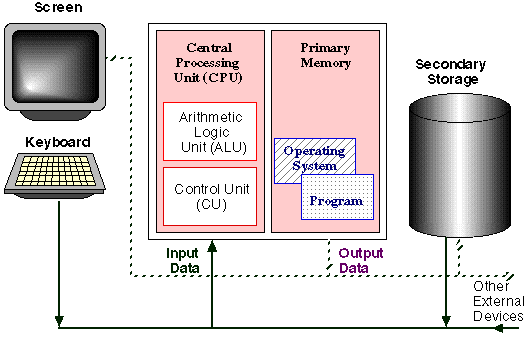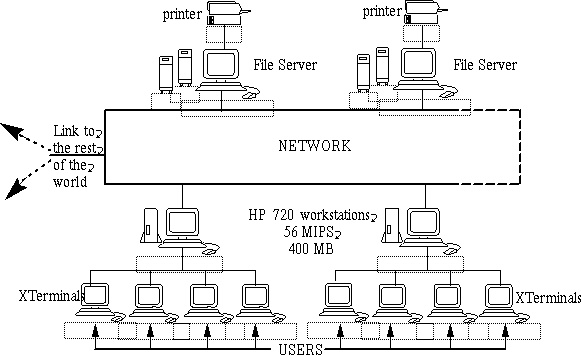
Question: "What is a Computer?"
Answer: "A Computer is a machine that can store and process data.
An overview of the basic constituents of a computer, assuming a PC (Personnel Computer) configuration, is given in the following Figure:

Points to note:
Computer memory, primary or secondary, can be thought of as a series of memory cells sometimes referred to as words. Each cell has an address associated with it which specifies its position in the memory. The number of memory cells in a computer varies but is usually measured in millions of cells. Each memory cell consists of a certain number of bits, usually 8, 16, 32 or 64 and each bit contains a binary digit, i.e. zero or one.
A group of 8 bits (binary digits) is called a byte. The size of memory is usually expressed in the unit kilobyte, shortened to Kb, which is 1024 (2^10) bytes. Storage capacity can also be expressed as a number of megabytes (Mb) approximately a million (2^20 = 1048576) bytes, or gigabytes (Gb) approximately a (US) billion (2^30 = 1073741824) bytes.
The following table represents a fragment of computer memory. Addresses are listed on the left, on the right are listed a series of 16 bit words each containing binary digits.
| 50004 | 0100 1101 1101 0000 |
| 50003 | 0000 1100 0111 0110 |
| 50002 | 0100 0001 0000 1001 |
| 50001 | 0010 0001 1111 1101 |
| 50000 | 0100 1100 0000 0010 |
Note that each address is represented by a unique number - in practice this is usually a hexi-decimal number. The lower end of the memory addresses range is often referred to as low memory (the other end is high memory). The operating system is normally located in low memory.
Data in secondary storage is organised into files. Conceptually a file is a named container in which a collection of data that belongs together can be stored. It might contain, for example, a program or input data for a program. Each file is given its own name so that it can be easily referred to. It is good practice to organise related files into directories and sub-directories according to (say) the nature of their application or the type of file. Use of directories allows users to organise their file store in a logical manner to prevent it from getting cluttered (more on this later).
A computer program comprises a series of instructions. An instruction tells the computer that it should perform a particular task. Examples included arithmetic instructions such as addition and subtraction, and logic instructions which evaluate to true or false. One measure of a computer's performance is the number of millions of basic instructions which are performed per second (MIPS - Millions Instructions Per second).
When a program is running in a computer, it is said to be executing. At this time a copy is contained in primary memory where it occupies a number of consecutive memory cells. Each instruction contained in the program is stored in a memory cell (or a group of such cells) and comprises a number of bits. Different instructions are represented by different combinations of bits in the cells (currently computers cannot operate using any other form of instruction encoding). As a program executes the CU reads the instructions contained in primary memory and carries them out. This will involve operations such as moving the contents of primary memory cells to the CPU and (if appropriate) invoking the ALU to (say) add two numbers together.
The command to execute a program comprises the name of the file in which the program is stored. The command causes the operating system to search for the required file in secondary memory and (if found) copy it into primary memory where it is then executed under the control of the CU. On completion control is returned to the operating system.
The Department's Computer System is known as a distributed computer system. The resources required by the users such as software, files, memory, printers, etc. are distributed amongst a number of machines in a variety of physical locations. All the components are connected via a network which transports information and requests between any two machines on the network. Thus, all resources are shared between all the users.

For further information regarding the facilities available within the department refer to the equipment section in the "Computer Science Introductory Guide".
Software may be applied in any situation for which a previously specified set of procedural steps (i.e. an algorithm) has been defined. Potential applications include the following:
Software that measures, analyses or controls real-world events as they occur in real time. Examples include plant monitoring and control systems.
Business information processing is the largest single software application area. Examples include payroll and stock maintenance systems.
Engineering and scientific software is often characterised by "number crunching" algorithms. Example applications include: astronomy, molecular biology, space shuttle orbital dynamics and volcanology.
Embedded software is used to control products and systems for consumer and industrial markets. For example key pad control on a micro wave oven, or fuel control in a sophisticated engine.
Artificial Intelligence (AI) software makes use of non-numerical algorithms to solve complex problems that are not amenable to computation or straightforward analysis. Example application areas include: pattern recognition, theorem proving and game playing.
Expert systems (also known as Knowledge Based Systems or KBS) are a branch of AI. They are designed to mimic the behaviour of an expert in some well defined field. Example applications include: medicine, geology and chemical analysis.
Created and maintained by Frans Coenen. Last updated 11 October 1999